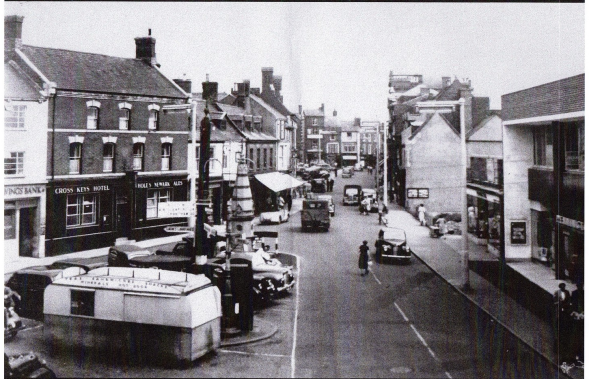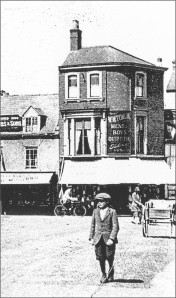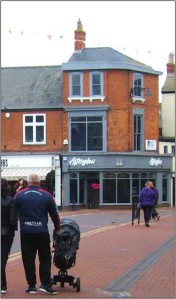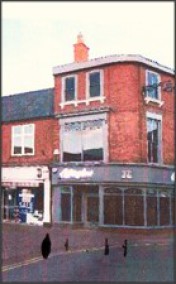2022: Heritage Impact Assessment - assessed
The planning application to install the Johnson Drinking Fountain in Ayscoughfee Gardens was first submitted by South Holland District Council on 4 April 2022. Two weeks later it was withdrawn. It was in need of “a few tweaks”, Councillor Grocock told the press.
Hall Place: circa 1953
The Heritage Impact Assessment presents a comparison between two possible locations for the fountain: Hall Place (town centre) and Ayscoughfee Gardens. The intention is to show the unsuitability of the first (principally because the historic monument, it says, would no longer harmonise with today’s Hall Place) and the suitability of the second. If, however, details of the analyses can be shown to be incorrect, uninformed or misleading, then the respective cases for the two locations will, at the least, be weakened.
Hall Place
(all references relate to the original Heritage Impact Assessment found here)
P.6 2.2 “The conservation area was designated in 1970 and was extended in 1975.”
UNINFORMED: It was further extended in 2009.
P.7 3.1 Image 2 The map shows No.24 (Kingston’s Corner) as a post-WW2 building.
WRONG: It was built in 1908.
P.7 3.1 Image 2 The map shows No.17 as a post-WW2 building.
WRONG: It is plainly visible in old photographs as early as the 1900s.
P.7 3.1 Image 2 Lloyd’s Bank is shown as a “nineteenth century building altered or refaced”.
WRONG: An 1887 photograph (Leveritt & Elsden: Aspects of Spalding, 1790-1930, p108) shows the building in its present form, unaltered.
P.8 3.2 No.19 is “the only one that is listed”.
WRONG: No.18 is also listed.
P.9 3.2 No.19 – “modern shop front”.
QUESTIONABLE: It is doubtful whether an Art Deco shop front from ninety years ago would any longer be considered “modern”, despite the national listing’s (1975)
description.
P.9 3.2 The northwest side’s buildings have been “extensively altered”.
EXAGGERATED: Most people glancing at an old photograph of the northwest side of Hall Place and a modern one would feel it was very little changed. Two-storey
buildings with pitched slate roofs and uneven roof-line. The same first-floor fenestration as before in the two new-build units (Savers and Gibbs). The former’s windows have been
carefully matched to earlier ones (small-paned sash with deep reveals). The main differences along the row are the partial loss of dormers and of course the changed shop fronts.
P.9 3.2 Pied Calf: “dormer windows removed” and another storey added.
IT ALL DEPENDS on which c.1900 photograph you look at. The changes seem to have happened about the turn of the century, some showing two storeys
and dormers, others three storeys. In which latter case today’s frontage architecture is little changed.
P.9 3.2 No.23 “The first floor fenestration has been changed.”
EXAGGERATED: The only change is the replacement of a bow window by a flat one. Everything else remains the same – window openings, dimensions, consoles, cornice,
stone trim.
P.9 3.2 No.23: The “pitched roof appears to have been removed.”
WRONG: The pitched slate roof remains exactly the same as when the building was built, save for a slightly deeper upstand round the eaves. It only needed one
or two steps from the Oglesby & Limb office into Hall Place to see this, instead of relying on a photograph taken too close to the building to show the roof (Image 5). The pitched
roof is also plainly visible in two modern photographs elsewhere in the HIA (Images 9 and 12).
P.11 3.5 “… the few buildings that are original have lost most of their features and have been altered beyond recognition.”
WRONG OR EXAGGERATED: See, for example, the p.9 entries above. Further, painted brickwork and grossly inflated fascias, as for example on
Nos.26 and 27 (The Card Factory and Ladbroke’s) could easily be returned to their original state.
P.12 3.5 “The urban, historical context …… varies significantly from when the fountain last occupied this
position.” (Repeated at p.29 8.1. )
WRONG (UNINFORMED?): On the contrary, apart from the loss of the Cross Keys Hotel and the remaining patch of bomb-site, the historical context of Hall Place
is pretty much what it was in 1954, when the fountain last stood there. The new dominating Pennington’s, now Boot’s, was built in 1952 – see the photograph at the start of this document – two
years before the fountain was removed. The old dominating Victorian or Edwardian Pennington’s (Image 6) had been destroyed in the May 1942 air-raid.
P.12 3.5 “The one [sic] listed building in the parade has been garishly painted ……”
AUNT SALLY: As if it couldn’t be repainted less garishly!
P.12 3.5 “There is risk of damage to the fountain by vehicle impact ……”
WRONG: A possible danger only if the fountain is positioned at exactly the same spot it occupied before –which no-one has ever suggested, to our knowledge. In
any case, it seems to have survived for many years unscathed from vehicle encounters of the closest kind. (See the 1953 photograph again.)
Ayscoughfee Gardens
P.17 3.5.3 The fountain “dates from 1847”.
WRONG: It was erected in 1874. (Copying error? Anderson & Glenn mistake not noticed? Typo?)
P.17 3.5.3 “Its connection to [Ayscoughfee Gardens] is that it was given to the town as a memorial to Mary Ann Johnson.”
MISLEADING: The implication that Mary Ann Johnson lived at Ayscoughfee Hall – she didn’t – is allowed to stand without correction or annotation.
P.26-28 Images 25-32 Proposed railings omitted from fountain mock-ups.
MISLEADING: The railings would be particularly prominent in Position 3, the one finally recommended.
P.27 7.2.1 “…… the seats facing away from it.”
AUNT SALLY: As if they couldn’t be turned round!
Commentary: Hall Place
It is puzzling that the HIA examines only two possible locations, only one of them in the town centre, when several other central sites have been suggested. Equally puzzling, given the clear public interest in the matter, is the lack of any public consultation.
In the absence of such a consultation, promised to the Town Forum by Councillor Grocock last September, the evidence of the public’s views that we do have – from letters to the press, social media, an on-line petition and a small snap poll – shows Ayscoughfee Gardens has virtually no support. The overwhelming choice is for the town centre. Particular locations suggested include Swan Walk, the Market Place and the southern end of Bridge Street. Otherwise, for most the wish is simply to see the fountain back “in the town centre”.
There is no explanation in the Heritage Impact Assessment itself of why analysis is confined to just the two locations.
The Council’s press release of 21 March 2022, however, makes it pretty clear. Such must have been the instructions issued to Oglesby & Limb. “The fountain, in erected form, has never been located anywhere else within the district,” says the PR, “and as such analysis of other sites was not considered appropriate.” Speaking to the press, Councillor Grocock repeated that the fountain had “only been in two locations and it’s got to go in one of them.”
Which is no argument at all. On this reasoning, Shakespeare’s female parts would still be being played by boys, because they always were in his day. Or the Channel Tunnel would be unbuilt, because the Channel had only ever been crossed by ships and planes before.
If there are other places in the town centre that might enable the fountain to make a greater contribution to its regeneration, and thus provide better value for money, it would seem to be short-sighted not to explore them. After all, when the fountain was exiled to Ayscoughfee Gardens in 1956, Spalding’s town centre was in no need of regeneration. Different circumstances now demand different approaches.
Most of the Heritage Impact Assessments errors and exaggerations, etc., arise from the wish to present Hall Place as looking so very different from 1874 or 1954 as to no longer provide a harmonious setting for the fountain. But the centres of all ancient market towns have a variety of architecture arising from the different times at which particular buildings were built or replaced. The variety is part of their attraction. Spalding is not a Victorian model village or a post-war ‘new town’.
In any case, Hall Place today is rather more like it was “when the fountain was last there” than Oglesby & Limb make out. See our discussion of the North West Parade, the photographs of No.23 above, and the right-hand side of the 1953 Hall Place photograph.
Nevertheless, this is not a plea to put the fountain back in Hall Place. A quick look round and an eye for streetscape design would show that to be a non-starter now. It needs no lengthy analysis. To put it on the (supposed) exact spot it occupied originally – never before proposed by anyone, to our knowledge – would simply produce clutter, with it squashed between seating circle and taxi-rank-cum-layby. The only two feasible sites are within the circle and the empty space to its north.
Within the circle it would obstruct our only real outdoor social space – central and far more popular than the back-to-back seats in the Market Place – and deprive the town of an obvious arena for entertainment. Recent examples are the Pumpkin Festival’s autumn leaves bubble and the Spring Fair’s maypole dancing. Not to mention the Christmas tree and the assembly point on which the churches’ Good Friday witness processions converge for a short service in the circle, this year joined by representatives of our Polish community. It is an invaluable asset. More could be made of it.
The seating circle has now become the focus of Hall Place, visually and in community terms. To put the fountain in the space near Gibbs would immediately create a visual conflict. It has the size and dignity to be an urban focus but would lack the central position such qualities demand. Just how isolated and unrelated to anything else it would appear can be seen in mock-up Image 12, where it looks spare, left over, cold-shouldered. The resulting streetscape would be uncomfortable, as if it couldn’t make up its mind. In short, Hall Place is no longer the place for the fountain.
Nor is Ayscoughfee Hall and Gardens.
Commentary: Ayscoughfee Gardens
Much is made of the connection between the Johnson family and Ayscoughfee. It was chosen as the new location for the rebuilt fountain, Councillor Grocock told the Town Forum (January 2022), because the Johnson sisters lived there. The Heritage Impact Assessment devotes several pages to the history of the Hall and Gardens and the Johnson family, whose genealogy is given twice. [Twice?] As a result, a reader without prior knowledge may well come to the conclusion that Mary Ann Johnson lived at the Hall, a connection that would give a fair reason for locating her fountain there. But Councillor Grocock is wrong. She didn’t live there at all. .That was another branch of the family. The two Johnson sisters lived at Fairfax House throughout their lives. (We provided the council copies of census returns to prove it.)
It is not entirely an oversight perhaps that, although Oglesby & Limb can twice find room to quote details about a couple of pictures in the Hall, they can’t find space to mention the crucial fact that Mary Ann Johnson never lived there. It would have undermined their case for re-siting the fountain in Ayscoughfee Gardens. The Heritage Impact Assessment does not actually say that Mary Ann Johnson lived at the Hall. It just manages to convey the impression that she did, culminating in the possibly ambiguous sentence: “The proposed works set out in this application seek to re-establish the connection between the fountain, Mary Ann Johnson and the Johnson family at Ayscoughfee Hall” (8.5).
The reasons advanced for choosing Ayscoughfee Gardens are empty. That it stood there for many years is neither here nor there if there is a more effective location within the town centre. The close personal connection claimed between Miss Johnson and the Hall is untrue.
Worse, although the paddling pool site is the best of three possibilities proposed, to locate the fountain in Ayscoughfee Gardens at all is to conceal its significance in the social history of the town, and to deny its very essence. The drinking fountain was a memorial to Mary Ann Johnson’s inestimable gift of pure spring water to the thousands of Spalding people hitherto dependent on more or less contaminated well water. It saved lives, the lives of ordinary people, not the well-to-do who had been able to afford fresh water by the bucket-full from water wagons. The lives saved were those of “the poor”, who had been gifted “the boon of pure water”, as the Free Press put it at the time. The form the memorial took was both imaginative and symbolic – the constant supply of pure water, free, to any passing carter, dairymaid, shop assistant, urchin or pedlar. Ordinary people. It needs, therefore, to be back amongst ordinary people again, going about their ordinary business and pleasures. That is, somewhere in the town centre. Not secluded in the former pleasure grounds of the local gentry, with pretty flowers and a keep-away fence, where it will appear as just another ornament, without meaning or significance.
The updated Heritage Impact Assessment supporting the resubmitted planning application, does appear to take on board our concerns about factual inaccuracy. However, our concerns about the process and lack of meaningful engagement and a proper assessment of all possible options for the fountain, remain outstanding as discussed in our newsletter which will be circulated soon.




